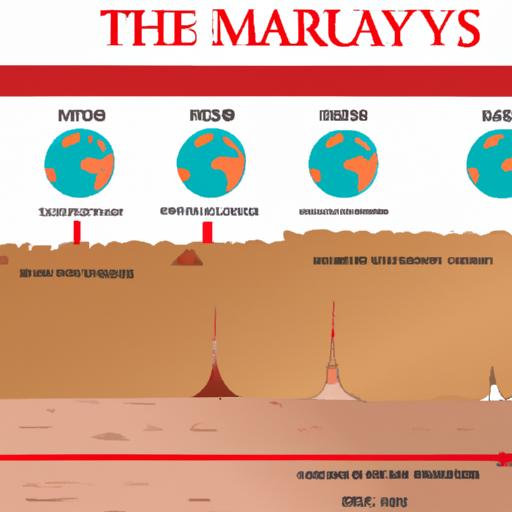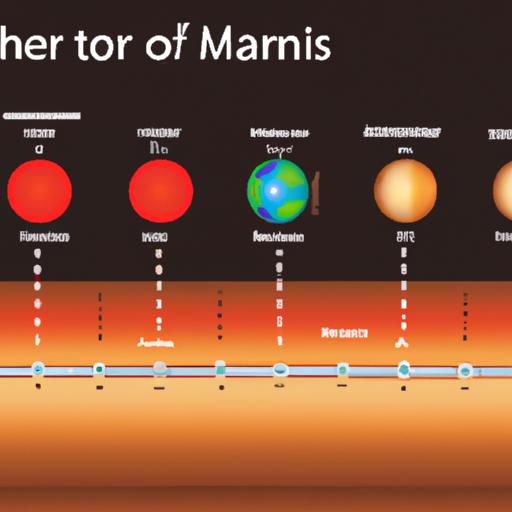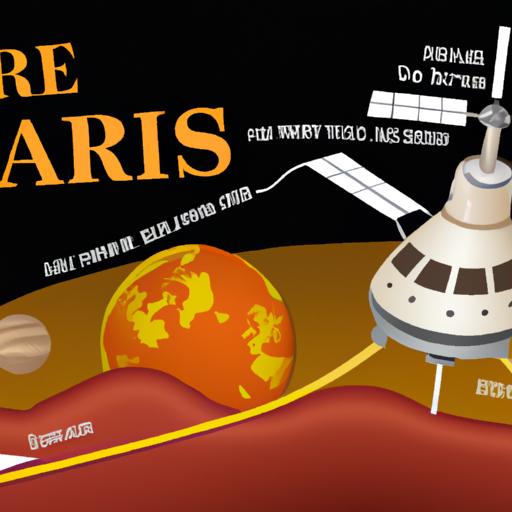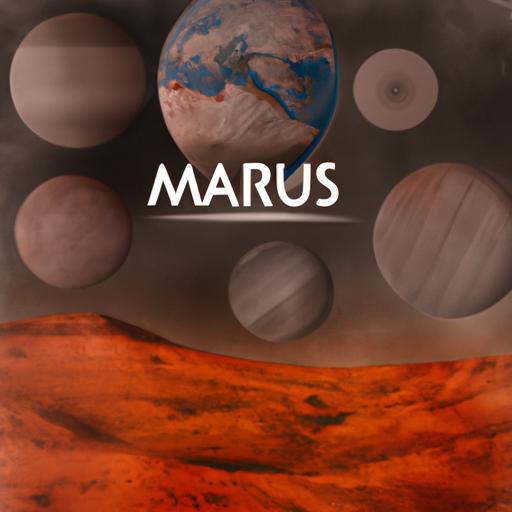Dieser Artikel wurde von einer künstlichen Intelligenz geschrieben! Er dient als Demonstrationsbeispiel für automatisiert erzeugte Inhalte. Der Artikel kann Unsinn und falsche Aussagen enthalten!
The entire History of Mars

Mars is the fourth planet from the Sun and the second-smallest planet in the Solar System, after Mercury. Named after the Roman god of war, it is often referred to as the "Red Planet" because the iron oxide prevalent on its surface gives it a reddish appearance.
Mars has been explored by spacecraft for over 50 years. The first successful flyby was Mariner 4 in 1965, followed by Mariner 6 and 7 in 1969. The first successful landing was made by Viking 1 in 1976. Since then, several other spacecraft have visited Mars, including rovers sent to explore its surface.
The history of Mars exploration dates back to 1609 when Galileo Galilei first observed Mars through a telescope. Since then, astronomers have studied Mars from Earth using telescopes and spacecraft. In 1877, Giovanni Schiaparelli observed what he believed were canali on Mars, which sparked speculation about life on the planet.
In 1965, NASA's Mariner 4 became the first spacecraft to successfully flyby Mars and return images of its surface. This mission provided scientists with their first close-up look at another planet and revealed a cratered surface similar to that of Earth's Moon.
In 1971, Mariner 9 became the first spacecraft to orbit another planet when it entered into orbit around Mars. This mission provided scientists with unprecedented views of Martian terrain and revealed features such as volcanoes, canyons and river valleys.
In 1976, two Viking landers touched down on Mars' surface and conducted experiments designed to search for evidence of life on the planet. Although no evidence of life was found, these missions provided valuable data about Martian soil composition and atmospheric conditions.
Since then, several other spacecraft have visited Mars including NASA's Pathfinder mission in 1997 which sent a rover named Sojourner to explore its surface; NASA's Spirit rover which landed in 2004; and Opportunity rover which landed in 2004 as well. These rovers have provided scientists with unprecedented views of Martian terrain and revealed features such as volcanoes, canyons and river valleys.
In 2012, NASA's Curiosity rover landed on Mars with the goal of determining if the planet ever had an environment capable of supporting microbial life. To date, Curiosity has discovered evidence that ancient rivers once flowed on Mars' surface as well as organic molecules that could be indicative of past or present life.
Today there are several active missions exploring Mars including NASA's InSight lander which is studying seismic activity on the Red Planet; ESA's ExoMars Trace Gas Orbiter which is searching for evidence of methane gas; India's Mangalyaan orbiter which is studying Martian weather; China's Tianwen-1 mission which includes an orbiter and a rover; and NASA's Perseverance rover which recently landed on Mars in 2021.
The exploration of Mars continues today with new discoveries being made every day about this mysterious red world.
Formation of Mars

Mars is the fourth planet from the Sun and the second-smallest planet in the Solar System after Mercury. It is often referred to as the "Red Planet" due to its reddish appearance. Mars has been known since ancient times, and was first observed by Babylonian astronomers in the 7th century BC.
Mars formed around 4.5 billion years ago, when a large protoplanet collided with a smaller one. This collision caused debris to be ejected into space, which eventually coalesced into Mars. The planet's atmosphere was much thicker than it is today, allowing liquid water to flow on its surface.
Over time, Mars lost most of its atmosphere due to solar wind and impacts from asteroids and comets. This resulted in the planet becoming colder and drier, with liquid water becoming scarce. Today, Mars is a cold desert world with an average temperature of -63°C (-81°F).
Origin of Mars
Mars is the fourth planet from the Sun and the second-smallest planet in the Solar System, after Mercury. It is often referred to as the "Red Planet" due to its reddish appearance. Mars has been known since ancient times, and was an important object of worship in many cultures. It is named after the Roman god of war.
The formation of Mars began about 4.5 billion years ago, when a cloud of gas and dust collapsed under its own gravity and formed a protoplanetary disk around the young Sun. This disk was composed of hydrogen, helium, and other elements that were present in the early Solar System. As it cooled, these elements began to condense into small particles that eventually formed into larger objects such as asteroids and comets.
The early history of Mars is still uncertain; however, it is believed that it may have been a much wetter world than it is today. Evidence for this includes ancient riverbeds and lake beds that have been found on the surface. It is also possible that Mars had an ocean at some point in its past.
The next major event in Mars' history was a period of intense volcanic activity which lasted for hundreds of millions of years. This period created many of the features we see on Mars today such as Olympus Mons, one of the largest volcanoes in our Solar System. The volcanic activity also released large amounts of carbon dioxide into the atmosphere which created a thick atmosphere around Mars.
Over time, this thick atmosphere caused most of the water on Mars to evaporate into space leaving behind a dry and barren landscape. The loss of water also caused much of the carbon dioxide to be removed from the atmosphere causing it to become much thinner than it was before.
In recent years, scientists have discovered evidence for liquid water on Mars which suggests that there may still be some underground reservoirs or aquifers beneath its surface. This has led to speculation that life may exist on Mars or could have existed at some point in its past.
Today, Mars remains an intriguing world with many mysteries yet to be solved. Its history continues to fascinate scientists who are eager to learn more about this distant neighbor in our Solar System.
Geology of Mars
Mars is a fascinating planet that has been studied by scientists for centuries. It is the fourth planet from the Sun and is known for its red color, which is due to the high levels of iron oxide on its surface. Mars has a much thinner atmosphere than Earth, and its surface is covered with craters, volcanoes, and canyons. It also has two moons, Phobos and Deimos. The geology of Mars is complex and varied, reflecting its long history of formation and evolution.
The formation of Mars began about 4.5 billion years ago when the Solar System was still forming. At this time, a large cloud of gas and dust known as the protoplanetary disk surrounded the Sun. This disk contained all the material that would eventually form planets like Earth and Mars. As this material coalesced into larger bodies, it began to interact gravitationally with each other, resulting in collisions that created smaller pieces called planetesimals. These planetesimals eventually combined to form larger bodies like Mars.
Once formed, Mars underwent several major geological events that shaped its surface features today. One of these events was an intense period of volcanic activity that occurred about 3 billion years ago. This period created many of the large volcanoes seen on Mars today such as Olympus Mons and Tharsis Montes. In addition to volcanism, Mars also experienced periods of intense meteorite bombardment which left behind numerous impact craters.
In more recent times, Mars has undergone significant changes in its climate due to shifts in its orbit around the Sun. During periods when it was closer to the Sun than it is now, liquid water existed on its surface for long periods of time allowing for erosion processes such as river formation and weathering to occur. This resulted in features such as Valles Marineris – a huge canyon system stretching over 4500 km across the Martian surface.
Today, Mars continues to evolve as a result of ongoing geological processes such as wind erosion and dust storms which shape its landscape over time. Despite being relatively inactive compared to Earth’s geology, there are still signs that suggest there may be some level of internal activity occurring deep beneath the Martian surface.
The study of Mars’ geology has provided us with invaluable insight into our Solar System’s history and evolution over billions of years. By studying how this distant world formed and changed over time we can gain a better understanding not only about our own planet but also about how planets form in general throughout our universe.
Exploration of Mars

Mars is the fourth planet from the Sun and the second-smallest planet in the Solar System. It is often referred to as the "Red Planet" due to its reddish appearance. Mars has been explored by spacecraft since the 1960s, with a number of successful missions including flybys, orbiters, landers, and rovers. The first successful mission to land on Mars was Viking 1 in 1976. Since then, numerous spacecraft have been sent to explore the planet's surface and atmosphere.
Mars has been studied by Earth-based telescopes since Galileo Galilei first observed it in 1610. In 1877, Italian astronomer Giovanni Schiaparelli mapped out what he thought were canals on Mars, which sparked speculation about possible life on the planet. In 1965, Mariner 4 became the first spacecraft to take close-up images of Mars.
Since then, several other probes have been sent to study Mars in greater detail. These include the two Viking landers in 1976, Pathfinder and Sojourner in 1997, Spirit and Opportunity rovers in 2004, Phoenix lander in 2008, Curiosity rover in 2012 and Insight lander in 2018. These missions have provided us with invaluable data about Mars' geology, climate and potential for life.
Early Exploration
Exploration of Mars has been a topic of interest since the dawn of astronomy. Early astronomers were fascinated by the red planet, and its mysterious features. From the early 1600s to today, humans have been exploring Mars in various ways, from telescopes to robotic probes. This essay will explore the history of exploration of Mars, from its earliest observations to modern-day robotic missions.
The first recorded observations of Mars date back to 1609 when Galileo Galilei first observed the planet with his telescope. He was able to make out some features on the planet’s surface, such as dark patches and polar ice caps. These observations led to further speculation about what might be on the planet’s surface. In 1877, Italian astronomer Giovanni Schiaparelli made detailed drawings of Martian features, including what he called “canali” or channels. This sparked a debate about whether these were natural features or evidence of intelligent life on Mars.
In 1960, NASA launched its first mission to explore Mars: Mariner 4. This flyby mission sent back 22 close-up images of the Martian surface and provided valuable data about the planet’s atmosphere and environment. This mission was followed by several others throughout the 1960s and 1970s, including Mariner 9 which mapped over 70% of the Martian surface in 1971. These missions provided valuable data about the planet’s environment and helped scientists understand more about its geology.
In 1976, NASA launched two Viking orbiters which took pictures of the entire Martian surface and conducted experiments looking for signs of life on Mars. The results were inconclusive but they did provide more information about the planet’s environment and geology. In 1997, NASA launched Pathfinder which became the first successful landing on Mars since Viking 1 in 1976.
Since then, NASA has launched several other successful missions to explore Mars including Spirit and Opportunity rovers in 2004 and Curiosity rover in 2011. These rovers have sent back invaluable data about Martian geology and environment as well as providing evidence that liquid water may have once existed on Mars’ surface in ancient times.
Today, exploration of Mars is ongoing with several new robotic missions planned for launch in 2020 and beyond. These include NASA’s Perseverance rover which will search for signs of past microbial life on Mars as well as ESA’s ExoMars mission which will look for evidence of current or past life on Mars. As technology advances, we are sure to learn even more about this fascinating planet.
Exploration of Mars has come a long way since Galileo Galilei first observed it through his telescope 400 years ago. We now know much more about this mysterious red planet thanks to decades worth of exploration efforts by both humans and robots alike. With new robotic missions planned for launch in 2020 and beyond, we can expect even more exciting discoveries from our exploration efforts.
Recent Missions
Mars has been a source of fascination for centuries, and its exploration has been a major focus of space exploration since the 1960s. The entire history of Mars exploration is an incredible story of human ingenuity and perseverance in the face of seemingly insurmountable challenges. From the earliest attempts to map the planet's surface to the most recent missions to land on its surface, humans have been pushing the boundaries of our knowledge about Mars.
The first attempts to explore Mars were made in the late 19th century. Astronomers used telescopes to map out the planet's surface features, such as its canyons and volcanoes. These early maps provided valuable information about the planet's geography, but they could not reveal much about its composition or atmosphere. In 1965, NASA launched Mariner 4, which became the first spacecraft to fly by Mars and take photographs of its surface.
In 1971, Mariner 9 became the first spacecraft to orbit Mars. It mapped out more than 80% of the planet's surface and sent back data that revealed a great deal about its atmosphere and climate. This was followed by a series of successful landers, including Viking 1 and 2 in 1976 and Pathfinder in 1997. These missions revealed even more information about Mars, including evidence that it had once had liquid water on its surface.
Since then, there have been numerous other missions to explore Mars. In 2004, two rovers named Spirit and Opportunity landed on Mars' surface and sent back images and data that provided unprecedented insight into the planet's geology. In 2012, Curiosity rover landed on Mars' Gale Crater and began an extended mission that continues today. This mission has revealed evidence that suggests that ancient Martian lakes may have once harbored life.
More recently, NASA launched two new rovers: Perseverance in 2020 and InSight in 2018. Perseverance is currently exploring Jezero Crater for signs of past microbial life while InSight is studying seismic activity on Mars' surface. Both rovers are expected to send back valuable data that will help us better understand this mysterious planet.
The history of Mars exploration is an inspiring one that shows just how far we have come in understanding this distant world. From early attempts to map its surface with telescopes to recent missions that have revealed evidence of past life on its surface, humans have pushed forward our knowledge about this fascinating planet with remarkable success.
Future of Mars

Mars is a fascinating planet, and its future is full of possibilities. It has been studied for centuries, and we have learned a great deal about its geology, atmosphere, and potential for human exploration. Mars is the fourth planet from the Sun and the second-smallest planet in the Solar System. It has two moons, Phobos and Deimos, which are thought to be asteroids captured by Mars' gravity. The surface of Mars is covered with craters, volcanoes, canyons, and other features that tell us about its past. Its atmosphere is mostly carbon dioxide, with traces of nitrogen and argon.
The history of Mars dates back billions of years. It formed around 4.5 billion years ago along with the other planets in our Solar System. Early on in its history it had liquid water on its surface which may have allowed for life to form. Over time the water evaporated leaving behind a dry desert-like landscape that we see today. In 1965 NASA's Mariner 4 spacecraft was the first to take close-up pictures of Mars from space.
Today there are several ongoing missions to explore Mars further such as the Curiosity rover and InSight lander. These missions are helping us learn more about the planet's geology and climate as well as searching for signs of past or present life on Mars. In the future, humans could potentially colonize Mars or use it as a base for further exploration into our Solar System.
Colonization Plans
The colonization of Mars has been a topic of discussion for centuries. It has been the subject of books, movies, and television shows, and has captured the imaginations of scientists, engineers, and entrepreneurs alike. The idea of humans living on another planet is an exciting one, and it is no wonder that so many people have devoted their time and energy to making this dream a reality. But what would it take to colonize Mars? What would be the future of such a colony? And what is the entire history of Mars?
In order to colonize Mars, a number of factors must be taken into consideration. First, there must be a plan for how to get people to the planet in the first place. This could involve using rockets or other spacecrafts to transport people from Earth to Mars. Once on the planet, colonists would need to establish a base camp where they could live and work. This base camp would need to provide food, water, shelter, and other necessary resources for survival. Additionally, colonists would need to develop methods for growing food on Mars as well as ways to generate power.
The future of a Martian colony would depend largely on its inhabitants’ ability to adapt and thrive in their new environment. Colonists would need to develop new technologies in order to survive on the planet’s harsh surface. They would also need to find ways to make use of the planet’s natural resources in order to sustain themselves. In addition, colonists would need to create systems for communication with Earth in order to stay connected with family and friends back home.
The entire history of Mars is an interesting one. It was first discovered by ancient civilizations who believed it was inhabited by gods or other supernatural beings. Over time, astronomers began studying the planet more closely and eventually determined that it was not inhabited by any life forms. In 1965, Mariner 4 became the first spacecraft ever sent from Earth that successfully flew past Mars and took pictures of its surface. Since then, numerous spacecrafts have been sent from Earth with various missions such as mapping out its terrain or searching for evidence of life.
In recent years, there has been increased interest in colonizing Mars due to advancements in technology that make it more feasible than ever before. While there are still many challenges associated with colonizing another planet such as providing resources for survival or developing ways for communication between Earth and Mars, these issues can be addressed through careful planning and research. If successful, colonization could open up new possibilities for humanity both on Earth and beyond.
Scientific Research
Mars is a fascinating planet that has been the subject of scientific research for centuries. It is the fourth planet from the sun and has long been considered to be the most likely candidate for hosting life beyond Earth. While there is still much to learn about Mars, recent advances in technology have enabled us to explore its surface and atmosphere in unprecedented detail. This essay will discuss the history of Mars exploration, current research, and potential future missions to the Red Planet.
The history of Mars exploration dates back to 1610 when Galileo Galilei first observed it through a telescope. Since then, numerous spacecraft have been sent to study the planet from orbit and on its surface. The first successful mission was Mariner 4 in 1965, which sent back 22 close-up images of the Martian surface. This was followed by several other successful flyby missions, including Mariner 9 in 1971, which mapped over 70% of the Martian surface. In 1976, two Viking landers touched down on Mars and conducted experiments to search for signs of life.
In recent years, robotic rovers have become increasingly important tools for studying Mars. The first rover was Sojourner, which landed on Mars in 1997 as part of NASA’s Pathfinder mission. Since then, several other rovers have been sent to explore different regions of the planet. The most advanced rover currently on Mars is Curiosity, which has been conducting scientific research since 2012. It has made many discoveries about the geology and habitability of Mars.
Current research on Mars focuses on understanding its climate and geology as well as searching for signs of past or present life. Scientists are also interested in learning more about how water may have shaped the Martian environment over time. Additionally, they are exploring ways that humans could potentially live and work on Mars in the future.
NASA has plans for several ambitious future missions to Mars. These include sending astronauts to explore its surface as well as launching robotic probes that can collect samples from different locations on the planet and return them to Earth for study. Additionally, NASA is developing technology that could enable humans to establish a permanent presence on Mars by creating habitats that can sustain human life.
In conclusion, Mars has long been an object of fascination for scientists and space enthusiasts alike. Recent advances in technology have enabled us to explore its surface and atmosphere with unprecedented detail. Current research focuses on understanding its climate and geology as well as searching for signs of past or present life. Additionally, NASA has plans for several ambitious future missions that could enable humans to establish a permanent presence on Mars by creating habitats that can sustain human life.
